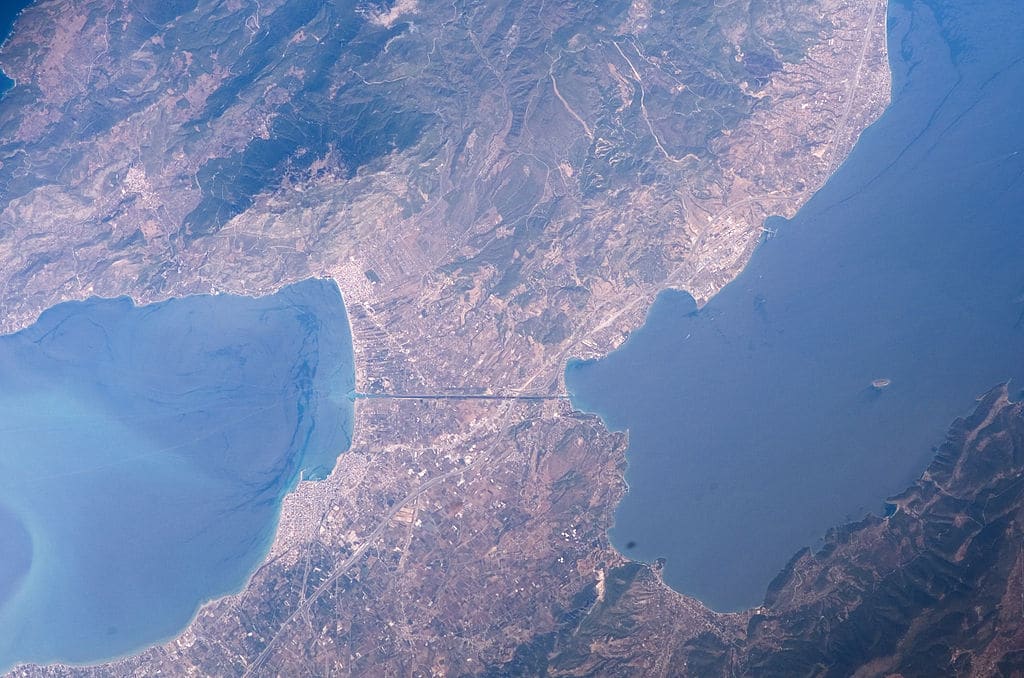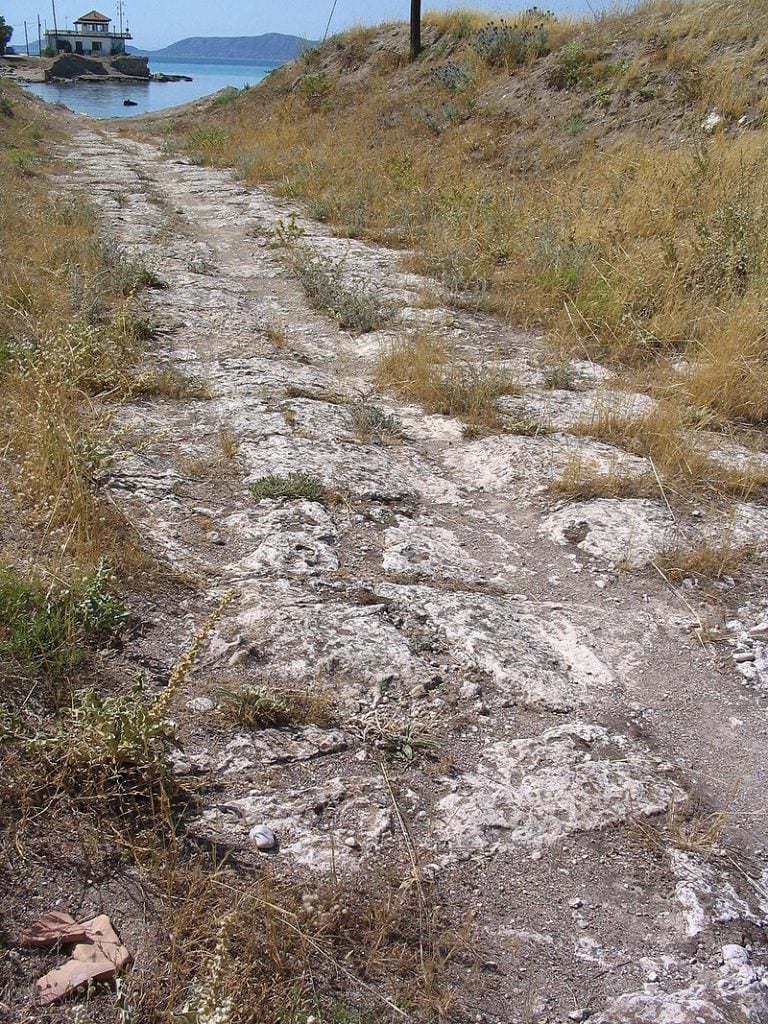
The Diolkos stone road, an ancient Greek engineering marvel, allowed ships to travel overland from the Ionian Sea to the Aegean, bypassing the Peloponnesian Peninsula.
Like the Corinth Canal, which was finally constructed millennia later, it made passage around the peninsula much safer for the vessels, but it also meant backbreaking labor for the unfortunate men who were tasked with pulling the vessels across the isthmus.
The cobblestone roadway upon which the ancients transported ships from the Corinthian Gulf to the Saronic Gulf is now being restored due to the efforts of the Greek Ministry of Culture as befits this wonder of technology and innovation.
The Diolkos stone road from antiquity still visible in some areas
Using a gigantic slipway that hauls ships up on dry land for construction and refurbishment, the Diolkos was a toponym for the work that went on there from antiquity through Roman times with the word indicating that something was being “drawn across” the land.
The ancient pathway, running roughly parallel to the modern Corinth canal, was considered one of the greatest technological feats of antiquity; incredibly, it can still be seen clearly in a few areas around Corinth, mainly on the property belonging to the School of Engineering there.
Eastward-bound ships would arrive at the northwestern end of the Diolkos at the current location of Poseidonia in Corinth where there was a stone ramp. They were then pulled up the ramps by slaves using giant ropes.
Then, the men hauled them onto a stout wooden frame, or sledge, atop the ramp. Once they were on dry land, the ships were then stripped of their masts and other movables to make them as light as possible.
The massive vessels then were turned on a ninety-degree angle to line them up with the Diolkos, using huge winches powered by several men. Next, they would be pulled up another stone ramp to get them atop an iron undercarriage.
Looking much like the undercarriages of a freight train today, these had huge wheels along both sides; they would transport the vessels all the way to the other end of the Diolkos. Even though the gradient of the road only went up to approximately three percent, it is still a feat of engineering and brute strength to move such huge vessels overland in this way.
Conjuring up scenes reminiscent of the slaves pulling and moving the massive blocks of the Pyramids in ancient Egypt, human power combined with great technological know-how allowed the Diolkos to function for many centuries.
Deep grooves in the stones ensured the undercarriage and its precious burden would stay firmly on track all the way to the other side of the isthmus.

Rediscovery of Ancient Greek texts pointed to construction of the Diolkos
Some historians believe that the ancient cobbled road carried not only warships but newly-constructed ships, as well, to their destination ports on either the Saronic or the Corinthian Gulf, and that wagons with passengers also utilized the stone roadway.
But this piece of engineering genius was tragically lost to human memory over time, as improvements to transportation technology along with the eventual building of the Canal negated any need for pulling vessels across the isthmus from one side of the Peloponnese to the other.
It was only in the 1800s that scholars, reading the works of the Greek historiographer Strabo (who was born in 65 BC) determined that the place name “Diolkos” also meant a physical passageway must once have existed there across the isthmus.

“Where the ships are hauled overland from one sea to another”
Strabo, who lived from 63 BC to 23 AD, had written that “the width of the isthmus of the Dialkos where the ships are hauled overland from one sea to another is forty stadia.”
Other ancient writers referred to the stone roadway as far back as the time of Aristophanes, who lived between 446 BC and 386 BC. Scholars even believe that his phrase “as fast as a Corinthian” referred to the Diolkos, meaning a Corinthian’s ability to get from Corinth to Athens quickly via the road.
Other Ancient Greek historians, including Thucydides, had also referenced the great passageway in their writings. In the fifth century BC, he wrote about the monumental transfer of ships that had taken place in the year 412 BC:
At the beginning of the next summer the Chians were urging that the fleet should be sent off, being afraid that the Athenians, from whom all these embassies were kept secret, might find out what was going on, and the Lacedaemonians at once sent three Spartans to Corinth to haul the ships as quickly as possible across the isthmus from the other sea to that on the side of Athens, and to order them all to sail to Chios, those which Agis was equipping for Lesvos not excepted.
Polybius, who lived in the second century BC, also mentioned the laborious hauling of no less than fifty ships across the isthmus in the year 220 BC by Demetrios of Pharos.
“But when Taurion heard of the Aeolian invasion, and what had taken place at Cynaetha, and saw that Demetrius of Pharos had sailed into Cenchrae from his island expedition, he urged the latter to assist the Achaeans, and dragging his galleys across the isthmus to attack the Aetolians as they crossed the gulf. Now though Demetrius had enriched himself by his island expedition, he had to beat an ignominious retreat, owing to the Rhodians putting out to sea to attack him: he was therefore glad to accede to the request of Taurion, as the latter undertook the expense of having his galleys dragged across the isthmus.”
Clearly, there was a practice of hauling ships across this neck of land, and, of course, it was the ancient Greeks who found a way to do it as quickly and efficiently as possible.
Following a gradual s-shaped curve but with a grade of no more than 1.5 percent, the cobbled road had a total length from one coast to the other of about eight kilometers (five miles) while its imposing width ranged from approximately 3.4 meters (11.15 feet) to six meters (twenty feet).
First systematic attempt to transport ships from Corinthian Gulf to Saronic Gulf
Archaeologists say that the Diolkos road, which enabled ships to avoid the 190 mile-long trip around the Peloponnesian Peninsula, was constructed at the end of the 7th century or at the beginning of the 6th century BC.
The idea for its construction is attributed to the ruler of Corinth at that time, Periandros, whose reign is characterized as one of great economic and artistic flourishing. The road was built on the borders of what are now the municipalities of Corinth and Loutraki-Perachora-Agios Theodoros.
Today, there are not only two main tracks of the road, which are approximately 1.5 meters (five feet) wide but also several secondary ones, as well, in some areas—possibly allowing for vessels being able to pass each other on the road while going in opposite directions.
In use from antiquity through the Roman period of Greek history, the Diolkos stretched from west of the present-day Corinth Canal to springs which were located in ancient Schinounta (present-day Kalamaki).
And the road wasn’t completely straight, going in a slight S-curve in accordance with the terrain it covered, making the journey even more difficult. This occasioned the construction of stone walls in certain places along the route to avoid derailments.
A system of tolls was in place for all those who used the road, benefitting the great city of Corinth. Some historians dispute whether or not the great stone roadway was used for commercial vessels, however; they believe that the merchants who owned them would never routinely risk the damage that could be incurred to their valuable ships by such transport for the benefit of avoiding the sea passage around the peninsula.
Other uses for the Diolkos may have included the transport of extremely heavy construction materials, including monumental stones, which were used in the city of Isthmia, at the eastern end of the pathway. The huge Panhellenic Sanctuary there, one of the largest in the Hellenic world, would host festivals every year, drawing crowds from all over Greece.
At six meters (twenty feet) wide, with marked parallel indentations spaced 1.5 meters apart, it seems clear that the road could support either these extremely heavy loads of stone or the typical commercial vessel of the time, which experts believe weighed up to twenty tons.
Despite the fact that, tragically, the engineering genius and the tremendous human effort involved in the construction of the Diolkos was forgotten for some time, most of the road is now overtopped with vegetation and even buildings as a result of the passage of time.
However, not only are the stones of the great roadway still there, but they soon will be uncovered and be viewable as a testament to the brilliance and the hard work of the ancient Greeks.
See all the latest news from Greece and the world at Greekreporter.com. Contact our newsroom to report an update or send your story, photos and videos. Follow GR on Google News and subscribe here to our daily email!



